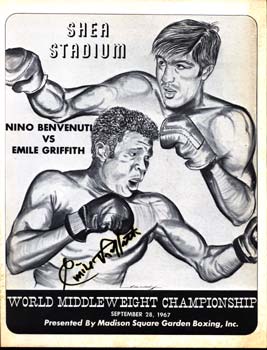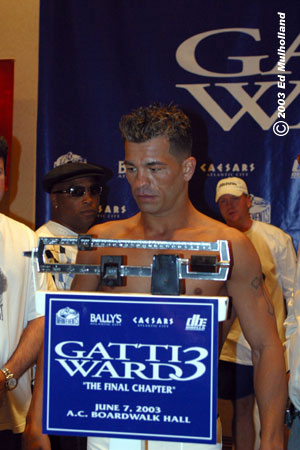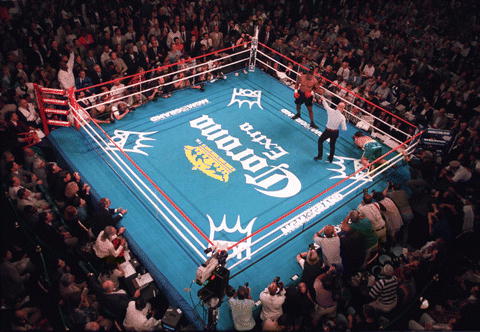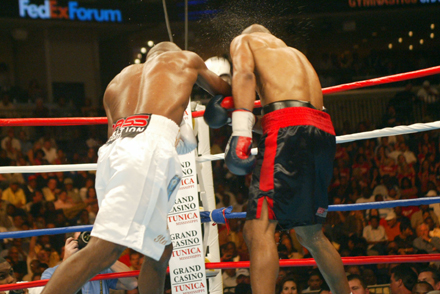|
RINSING OFF THE MOUTHPIECE
by
GorDoom
First
off, the Olí Spit Bucket wants to give HUGE props to Dan Klepner,
Dean Vios and Todd Hodgson, without whom the last two issues of
WAIL! would never have been published.
These three young guys have really reenergized the CBZ with their
talents and enthusiasm. All of them first started by posting on
the CBZ Boxing Board and then volunteering to help out.
I owe you guys, youíre the best!
*********
There have been some things Iíve been wanting to get off my chest
lately:
WEIGHT
CLASSES
Isnít anybody besides me outraged at the fact that two fighters
enter a ring for a junior-lightweight title bout and one of them
comes in as a junior-welter and the other a full-fledged welter?
This
kind of sitch isnít an aberrationóit has become de rigueur.
Itís so common that hardly anybody notices or comments on
it. In fact, if it werenít for HBO providing empirical proof before
each match, it wouldnít even be an (albeit somehow minor) issue.
Same-day weigh-ins got tossed by the wayside back in 1981, when
Eddie Mustapha Muhammad came in overweight for a light-heavyweight
unification match with Michael Spinks. Back in the day, this was
a legit superfight with all the attendant hoopla.
Spinks refused to go through with the fight, even after Eddie
proposed just making it a nontitle go. Spinks was pissed because,
as he said, he sacrificed and trained hard to make the weight,
and if Muhammad couldnít bother to do the same, then screw it
...
The
promoter, HBO, th e
alphabets and the commissions decided that in the future, all
weigh-ins would be the day before, so that a cancellation like
this would never happen again. e
alphabets and the commissions decided that in the future, all
weigh-ins would be the day before, so that a cancellation like
this would never happen again.
This is real b.s., and it was never more clear to me than after
rewatching the second middleweight title bout between Emile Griffith
and Nino Bevenuti, which took place in 1967.
The fight was outdoors at Shea Stadium, and they both weighed
in the day of the fight. Benvenuti weighed 160 pounds and Griffith
weighed 155 pounds. There was inclement weather that afternoon,
and the fight got postponed to the next day.
The next day, they weighed in again, and Benvenuti weighed 159!
and Emile weighed 154! Thatís unheard of today, when we regularly
see fighters put on 10 to 20 pounds between the weigh-in and the
fight.
I think something has to be done to make sure fighters are fighting
at least NEAR their natural weight. Remember the Gatti-Gamache
fight? Gatti came in as a middleweight and Gamache as a junior-welter, and Gatti damn near killed him.
and Gamache as a junior-welter, and Gatti damn near killed him.
We should go back to same day weigh-ins. The b.s. about fighters
being too dehydrated doesnít wash. Fight at your natural weight
and you wonít be dehydrated. I really donít know what the solution
is, but having fighters weigh a weight class or three above the
title theyíre fighting for is absurd.
The dehydration talk was just a bunch of blah, blah, blah... The
main concern was lost revenue, screwed-up TV schedules and the
huge expenses for the advertising, the venue and the people hired
to work the show.
The promoters are on the hook for all that. And yeah, Iím cynical,
but I believe thatís the real reason for the current mess today.
Plus, I donít think anybody foresaw or cared about the consequences.
It really is fundamentally WRONG when a welterweight and a junior-welterweight
are vying for a junior-lightweight title.
RING
LOGOS
Unlike athletes in other sports, boxers get squat when it comes
to their rights and protection. Itís hard enough JUST to get into
a ring to fight somebody, and itís outrageous that they now have
to worry about their footing.
Not only do Miller Lite and Budweiser have big logos in the center
of the ring, but they also have logos in all four corners.
Unbelievable!
Maybe Iím noticing them more lately but I donít think Iíve ever
seen five [!!!] logos in a boxing ring before. Talk about overkill
... But then, to make matters even worse, there are also ESPN2
logos along all four sides of the ring. In other words, there
is virtually no place that the fighters donít have at least
one foot on a logo at any given time during the fight.
This
is patently ridiculous with the advent of technology. Television
networks can project images onto the field of play during telecasts
using camera tricks. (For example, the yellow first-down line
on football broadcasts.) Canít the networks engineer the broadcasts
so that the logo images appear on the screen without physically
being stuck on the canvas itself? Alternatively, canít some sort
of protective coating be placed on the canvas that would give
fighters traction when crossing a logo?
Of course, this would mean the networks would have to pony up
some extra cash to implement this. Whatís it going to take? A
fighter like Oscar or Hopkins slipping and breaking a leg during
a major PPV? Or will some common sense suddenly course through
the network executivesí veins and actually lodge in their brain
pans?
*********
In
closing, I have to comment on the body blow boxing has suffered
with the recent KOís of Oscar De La Hoya and Roy Jones. The
sad fact is that they were really the only two major stars boxing
has at this point. Who else is there that can command the media
attention, ticket sales and PPV buys?
Add Ol' Leg-Iron Mike's recent loss to the mix and
the three biggest names in boxing are on the skids. There are
no prospects coming up that create the huge media waves that
those three always bring to a fight.
No
matter how anyone might feel about them, it's apparent that
with nothing coming up from the last Olympics and no younger
fighters taking their place, boxing is reeling at this juncture.
As
for the fights, I give huge credit for Oscar for even taking
the fight not to mention that he CAME to fight. But Bernard
was a bridge too far for Oscar, who did his utmost but ultimately
went down to the bigger man.
Unlike
Roy, Oscar stepped up to the plate and fought everybody the
public wanted to see him against. Although there are many reasons
to dislike Oscar, there is no getting around that heís been
a true warrior willing to meet any challenge.
One
thing that bothers me about the fight is the laziness of the
media in describing the final fatal blow. Every media outlet
has pronounced it as a classic left hook to the liver.
Nothing
could be further from the truth.
Oscar
was hit by a punch on the back of the floating rib and kidney.
This is a paralyzing punch and the same sweet spot that Roy
hit Virgil Hill on. But the media, including people like Bert
Sugar and Max Kellerman are all parroting the hook-to-the-liver
balderdash.
Most
newspaper reporters know squa-doosh about boxing, but I know
Max and Bert know better. I mean, itís just about impossible
to hit somebody in the liver when he is bent over like Oscar
was.
Royís
sitch is a different case. Manny Steward probably put it best:
ďWhat
really concerns me is that Iíve never seen an elite fighter
go out like thatóever. Not [Sugar Ray] Robinson, not Ali, not
anybody. He was knocked out twice. I donít mean TKOídóI mean
knocked out before he even hit the floor.Ē
That
pretty much says it all. Royís comedown and failure is
something that doesnít happen to elite fighters: Leonard, Hearns,
Hagler, Chavez, Azumah, Pea, Foreman,and so on.
People
are going to get mad, because people are in denial. But Royís
failure IS monumental, and thereís no getting around it. When
he faced adversity, he folded.
Jon
Saraceno brought up a good question in a USA Today column:
What would have happened if Roy had faced adversity earlier
in his career? Thatís a question that will float over Royís
legacy like a shroud. Because when push came to shove against
Johnson, he showed no fire, no heart, no fighting spirit.
Itís
like Roy was the bully on the block (much like Mike Tyson),
and when the bubble was punctured, there was no there, there.
Hell, Tyson showed WAY more fire against Williams.
This
is a stain on Royís career and there is no getting around it.
The years of fighting beat cops and garbage men and the rest
of the trash-heap alphabet contenders caught up with him. When
somebody actually fought back hard, he simply didnít know what
to do and couldnít handle it.
Ali,
Leonard and Pea: When their talents devolved, they tried to
adjust and they still fought back and tried to win.
Roy
didnít. And no matter how many excuses anybody comes up with
there is NO getting around that fact. I see no reason that Roy
shouldnít be judged by the same standards we judge other greats.
Jonesí
refusal to fight Tarver again immediately was telling. Lennox
Lewis has been hammered by the critics for twice being KOíd.
But he came back and avenged both losses, which is something
Roy wonít or canít do. If we are going to criticize Lewis, then
thereís no reason Roy shouldnít be held accountable for his
failures ...
Royís
main problem is that he was so physically gifted that, like
the young Cassius Clay, he got away with his lack of fundamentals.
For instance, Roy never really learned how to really use a jab.
He was so fast that he could use left hooks instead.
And
Roy got sloppy. As soon as the reflexes degraded, he had nothing
to fall back on. There was no Plan B, because he never learned
how to properly fight.
He
simply doesnít KNOW how to adjust his style. As all the great
fighters got older, they adjusted. Todd Hodgson has brought
up Erik Morales and the subtle adjustments heís made over the
past few years. You can say the same for Marco Antonio Barrera.
Go back a few years and there is Chiquita Gonzales. His first
fight with Michael Carbajal was one of the great wars of the
í90s, but he got stopped. In his next two fights with Carbajal,
he radically changed his brawling style, adjusted, and won the
next two bouts via tactical decisions.
Thatís
what great fighters do: They find a way to win. Roy couldnít,
because he lacked the fundamentals. Roy couldíve won the Johnson
fight if he had jabbed and moved and given angles. Instead,
he mostly stayed on the ropes, because he couldnít handle the
pressure of a fighter that wasnít scared.
Ya
gotta have a Plan B and a Plan C, or youíll end up crashing
and burning.
One
last thing: I rewatched the second Tarver fight, and up until
the KO, Roy looked the same as ever. He won the first round
easily and looked good until he got caught. I really think this
loss was more a case of hubris and lack of proper boxing fundamentals
than that Roy is shot.
*********
Well,
thatís it for now. I hope everybody enjoys the new issue and we
will be back next month.
GorDoom
Top
of Page
|

